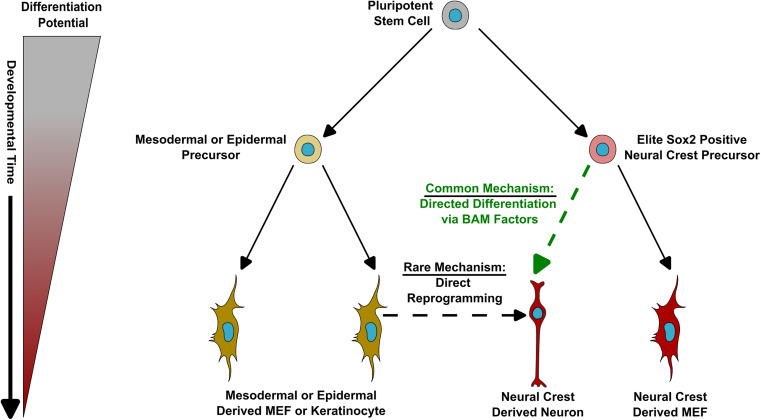Posted 15 November 2024 - 05:00 PM
Scientists have shown that in a direct cellular reprogramming scenario, neurons are produced almost exclusively by a rare subtype of multipotent cells. Their findings, they claim, change our understanding of reprogramming, but not everyone agrees [1].
Direct action
In the world of cellular reprogramming, the two most well-known realms are pluripotent reprogramming, in which somatic cells are thrown back all the way into pluripotency, and partial reprogramming, in which these cells are rejuvenated without making them lose their cellular identity.
However, there is a third route called direct reprogramming, in which somatic cells are directly transformed into differentiated cells of another type [2]. A similar process happens in the body naturally in some cases, but scientists have learned to facilitate it by expressing certain factors. Transitions have been reported even between relatively distant cell types.
Both direct and pluripotent reprogramming are characterized by low efficiency, with only a fraction of the cells making the transition. There are two types of theories as to why this happens. According to one, due to multiple stochastic changes accumulated throughout cells’ lives, some of them lose the ability to transition. The other posits that from the start, only a small subset of cells has the properties necessary for transitioning.
It takes a special type of cell
In a new study published in Stem Cell Reports, researchers from the university of Toronto set out to test those theories in neonatal murine fibroblasts, which are thought to be able to transition into neurons.
The scientists obtained the cells for reprogramming from the head-and-neck region of mouse embryos. They then applied a standard protocol for direct reprogramming by virally delivering and overexpressing three neuron fate-specifying transcription factors: BRN2, ASCL1, and MYT1L, collectively known as BAM.
It is generally assumed that a large majority of cells in such a culture are murine embryonic fibroblasts (MEF) and that treating them with BAM should produce neurons, albeit with low effectiveness. What the researchers found, however, is that almost all induced neurons could be traced back to a subset of stem-like “neural crest cells”, specialized cells that originate in the developing embryo along the edges of the neural tube, the precursor to the central nervous system.
These cells can turn into a variety of cell types, including smooth muscle cells, osteoblasts, melanocytes, and fibroblasts. However, as the researchers found, they don’t disappear past the early development stage. Instead, a small number of NC cells lingers in the tissue. According to the paper, induced neurons originate almost exclusively from those NC cells.
The researchers performed several experiments to validate their findings, including the depletion of NC cells in culture, in which case, there was almost no transition into neurons.

Overturning the consensus?
This study’s results question the idea that a differentiated cell can be induced to directly transition into a distantly related cell type.
“We believed that most cases of cell reprogramming could be attributed to a rare, multi-potential stem cell that is found throughout the body and lays dormant within populations of mature cells,” said Justin Belair-Hickey, first author on the study and graduate student of U of T’s Donnelly Centre for Cellular and Biomolecular Research. “It was not fully understood why reprogramming tends to be an inefficient process. Our data explain this inefficiency by demonstrating that the neural crest stem cell is one of the few stem cells that can produce the desired reprogrammed cell type.”
“I think claims about direct reprogramming are either overstated or based on inaccurate interpretations of the data. We set out to demonstrate that the identity of a cell is much more defined and stable than the field of cellular reprogramming has proposed. At first glance, it appears that we’ve found skin cells that can be reprogrammed into neurons, but what we’ve actually found are stem cells in the skin that are derived from the brain.”
“Neural crest stem cells may have gone unnoticed by others studying cell reprogramming because, while they are widespread throughout the body, they are also rare,” said Derek van der Kooy, principal investigator on the study and professor of molecular genetics at the Donnelly Centre and U of T’s Temerty Faculty of Medicine. “As such, they may have been mistaken for mature cells of various types of tissue that could be reprogrammed into other cell types. I think what we’ve found is a unique group of stem cells that can be studied to understand the true potential of cell reprogramming.”
Relevance to the field
While their new paper focuses on direct reprogramming, the researchers mention their earlier 2019 study into pluripotent reprogramming [3], in which “a subset of MEFs exhibited an a priori propensity for reprogramming and dominance.”
However, some other researchers caution against generalizing the results. Vittorio Sebastiano, associate professor at Stanford, who is also a co-founder and SAB chair at the reprogramming-related startup Turn Biotechnologies, said to Lifespan.io: “The work is certainly interesting, but the conclusions cannot be generalized. iPSCs (induced pluripotent stem cells) can be made from many different cell types. While skin fibroblasts are poorly and loosely characterized (which may support the authors’ claims), in other reprogramming experiments, more defined and characterized cell types, such as blood cells, are used.”
“While it is important to understand the process of full reprogramming, at the end of the day, making sure you have iPSCs is what matters, and also that their pluripotency and differentiation potential are established. In summary, while understanding how the full reprogramming to pluripotency is important, these results do not really ‘cripple’ any of the findings that have been made so far.”
According to another cellular reprogramming entrepreneur, Yuri Deigin, co-founder and CEO of YouthBio Therapeutics, “these findings are specific to direct lineage reprogramming and do not impact our understanding of full pluripotent reprogramming using the Yamanaka factors.”
“Contrary to the overarching idea from the authors’ 2019 paper — that reprogramming efficiency is driven by rare ‘elite’ clones — recent work by Konrad Hochedlinger and colleagues demonstrated that transient inhibition of H3K36 methylation enables nearly 100% of somatic cells to reprogram into iPSCs,” he said. “This indicates that all cells have the potential for reprogramming when certain epigenetic barriers are overcome. While it is true that under standard conditions, only a small fraction of cells typically reach full pluripotency, this limitation is not inherent.”
We would like to ask you a small favor. We are a non-profit foundation, and unlike some other organizations, we have no shareholders and no products to sell you. All our news and educational content is free for everyone to read, but it does mean that we rely on the help of people like you. Every contribution, no matter if it’s big or small, supports independent journalism and sustains our future.
Literature
[1] Belair-Hickey, J. J., Fahmy, A., Zhang, W., Sajid, R. S., Coles, B. L., Salter, M. W., & van der Kooy, D. (2024). Neural crest precursors from the skin are the primary source of directly reprogrammed neurons. Stem Cell Reports.
[2] Wang, H., Yang, Y., Liu, J., & Qian, L. (2021). Direct cell reprogramming: approaches, mechanisms and progress. Nature Reviews Molecular Cell Biology, 22(6), 410-424.
[3] Shakiba, N., Fahmy, A., Jayakumaran, G., McGibbon, S., David, L., Trcka, D., … & Zandstra, P. W. (2019). Cell competition during reprogramming gives rise to dominant clones. Science, 364(6438), eaan0925.
View the article at lifespan.io










































